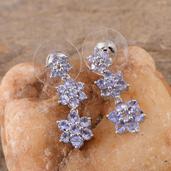It has better fire than the tourmaline elbaite or peridot and an adequate hardness. Its only one direction of cleavage is somewhat of a problem because it is oriented with the direction of strongest pleochroism. This would be a problem in most gemstones because that is the direction the gemcutter would usually select to maximize the color. However, with tanzanite the color is usually strong enough anyway.
Pleochroism is very pronounced in tanzanite and is seen as three different color shades in the same stone. In the viewing a tanzanite stone, the colors dark blue, green-yellow and red-purple can be seen, all a result of pleochroism. Lesser stones may have a brownish color due to the mixing of blue, purple and green. These stones are usually heat treated to a deep blue color. Iolite is a blue-violet gemstone variety of the mineral cordierite, has strong pleochroism and can be confused with tanzanite. However, iolite is usually less strongly colored, its pleochroic colors vary from blue-violet to yellowish gray to blue and it has less fire. Iolite's unusual color shades makes it an exotic colored gemstone whose popularity is growing day by day.
Nearly all tanzanite has been heat treated to generate the beautiful violet-blue color this stone is known for. When first mined, most stones are a muted green color. The only known source of Tanzanite is a five square mile hilltop at Merelani, ten miles south of the Kilimanjaro International Airport in Tanzania.

 RSS Feed
RSS Feed


